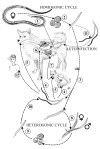Strongyloides stercoralis infection in a Finnish kennel
- PMID: 18076758
- PMCID: PMC2225404
- DOI: 10.1186/1751-0147-49-37
Strongyloides stercoralis infection in a Finnish kennel
Abstract
Background: Intestinal threadworm Strongyloides stercoralis is a parasite of dog, cat and primates that occurs worldwide being most prevalent in tropical and subtropical countries. The adult parasitic worm is about 2 mm long and slender. It possesses both parasitic and free-living lifecycles. The parasitic worms are females. Strongyloides stercoralis infects the host via percutaneous, peroral or transmammary transmission in addition to autoinfection. Clinical disease varies from inapparent to severe enteritis and pneumonia. The diagnosis is based on demonstration of larvae in fresh faeces, which is best made by Baermann technique.
Case presentation: Strongyloides stercoralis infection was diagnosed in autopsy in a 10-week-old puppy born and raised in a Finnish kennel. Prior to its sudden death, the puppy had suffered from gastrointestinal disturbance for three weeks. Subsequent sampling of the dogs in the kennel revealed that three adult dogs in the kennel were also infected.
Conclusion: The present case shows that S. stercoralis can complete its life cycle and cause disease in dogs also in Northern Europe. Infection can be maintained also in a temperate climate and may become a chronic problem in a kennel environment. Infection may be underdiagnosed as Baermann technique is not routinely performed in small animal practice.
Figures



References
-
- Roberts LS, Janovy J. Nematodes: Rhabditida, pioneering parasites. In: Gerald D. Schmidt, Larry S, editor. Roberts' Foundations of parasitology. New York, USA, Mc Graw-Hill; 2005. pp. 411–416.
-
- Georgi JR, Georgi ME. Strongyloides. In: Georgi JR, Georgi ME, editor. Canine Clinical Parasitology. Malvern, PA, USA, Lea & Febiger; 1992. pp. 160–165.
-
- Grove DI. Human Strogyloidiasis. In: Baker JR, Muller R, Dollison R, editor. Advances in Parasitology. Vol. 38. Academic Press; 1996. pp. 251–309. - PubMed
-
- Nolan TJ. Canine Strongyloidiasis. 2001. http://www.ivis.org/advances/Parasit_Bowman/nolan_strongyloidiasis/chapt... Accessed May 30, 2007.
-
- Bowman DD. Georgi's parasitology for veterinarians. USA, W. B. Saunders Company; 2003. pp. 197–200.
Publication types
MeSH terms
LinkOut - more resources
Full Text Sources
Miscellaneous

